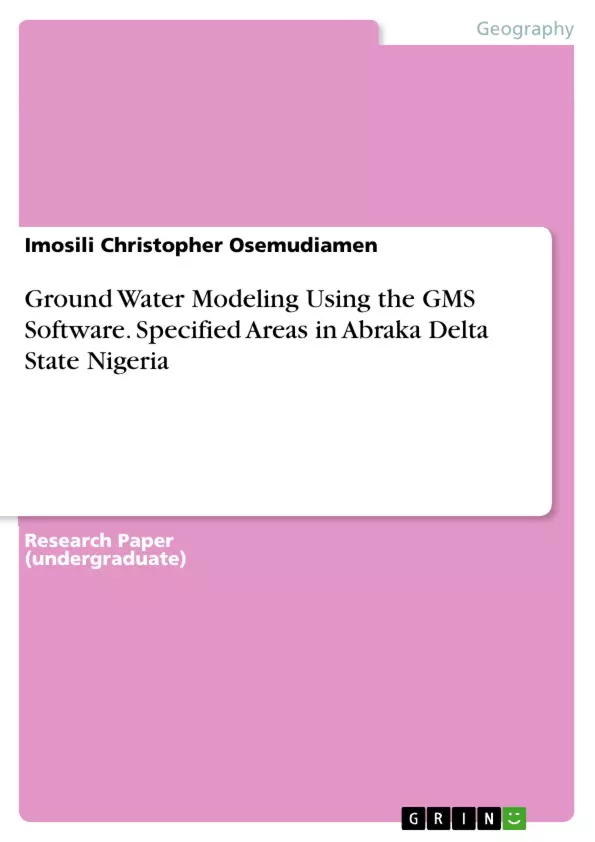This work presents the results of groundwater flow modeling in Abraka using the groundwater modeling software (GMS) which supports the MODFLOW as well as the MOD PATH. The model covers the three campuses of Delta State University and environs. A conceptual groundwater modeling approach was employed for the purpose of modeling; the source/sink coverage, recharge coverage, well extraction coverage, river leakage starting heads, Ibound, the top and bottom elevation, hydraulic conductivity and anisotropy; and later calibrated to get the residual of the computed heads verse the observed heads.
The hydraulic sensitivity likewise the effect of recharge and pumping rate was ascertained after calibration. The direction was ascertained as it moves in the direction of the Ethiope river with the velocity of the vector movement of the MODFLOW is given as 0.70016372204 m/day (8.1037465278×10-6 m/sec); likewise the MODPATH of which contaminant flows in the opposite direction of the river and few moving through the wells down to the aquifer with a porosity of 0.8 .volumetric analysis shows the total inflow of water is 138,069.96886253 and outflow -138,076.472868 with a difference of -6.504005432129.
The percent discrepancy value of the model is -0.0047% .This also shows the closeness the model is represents the groundwater condition in the study area The value of the total recharge rate on the aquifer is 12,728.870018005.
Inhaltsverzeichnis (Table of Contents)
- 1.0 INRODUCTION TO GROUND WATER AND AQUIFER SYSTEM
- 1.1 TYPES OF AQUIFERS
- 1.2 CLASSIFICATION OF AQUIFERS
- 1.3 AIM AND OBJECTIVES
- 1.4 LITERATURE REVIEW
- 2.0 GEOLOGY OF THE STUDY AREA
- 2.1 LOCATION OF STUDY AREA
- 3.0 MATERIALS AND METHODOLOGY
- 3.1 DIGITAL ELEVATION MODEL
- 3.2 FLOW SIMULATION
- 3.3 CREATING THE GRID
- 3.4 ASSIGNING IBOUND ARRAY
- 3.5 TOP AND BOTTOM ELEVATION
- 3.6 STARTING HEADS
- 3.7 LAYER PROPERTY FLOW (LPF) PACKAGE
- 3.8 ANISOTROPY
- 3.9 OPTIONAL PACKAGES
- 4.0 SIMULATION OF MODEL
- 4.1 VOLUMETRIC ANALYSIS
- 4.2 ZONE BUDGETING/FLOW BUDGET
- 4.3 CALIBRATION
- 4.4 CONTAMINANT PREDICTION/PARTICLE TRACKING
- 5.0 CONCLUSION
Zielsetzung und Themenschwerpunkte (Objectives and Key Themes)
This text explores the critical role of groundwater resources in meeting the increasing demand for fresh water for domestic, agricultural, and industrial purposes, especially in developing countries like Nigeria. It focuses on the geological and hydrogeological aspects of groundwater resources, examining the characteristics, distribution, and management of aquifers. The study aims to develop a comprehensive understanding of groundwater systems and to evaluate their potential for sustainable development.
- The significance of groundwater resources and their challenges in meeting water demands
- The geological and hydrogeological characteristics of aquifers
- Methods for analyzing and simulating groundwater flow and contaminant transport
- The application of geophysical techniques for assessing groundwater resources and contamination
- Strategies for sustainable management and protection of groundwater resources
Zusammenfassung der Kapitel (Chapter Summaries)
- Chapter 1: Introduction to Groundwater and Aquifer System
This chapter introduces the concept of groundwater and its significance as a natural resource. It discusses various types of aquifers, their classification, and the challenges associated with their development and management. The chapter also emphasizes the need for efficient methods to assess groundwater resources and vulnerability.
- Chapter 2: Geology of the Study Area
This chapter provides an overview of the geological setting of the study area, focusing on the location and characteristics of the relevant geological formations that influence groundwater distribution and availability.
- Chapter 3: Materials and Methodology
This chapter describes the materials and methods used in the study, including the use of digital elevation models, flow simulation techniques, and the creation of grid models for analyzing groundwater flow. It also discusses the application of the Layer Property Flow (LPF) package for simulating aquifer behavior.
- Chapter 4: Simulation of Model
This chapter details the process of simulating groundwater flow within the study area, using the methodologies outlined in previous chapters. It covers volumetric analysis, zone budgeting, calibration techniques, and contaminant prediction using particle tracking methods.
Schlüsselwörter (Keywords)
Groundwater, aquifer, hydrogeology, geology, simulation, digital elevation model, flow budget, contamination, vulnerability, sustainable management, geophysical methods, particle tracking, Nigeria.
- Citar trabajo
- Imosili Christopher Osemudiamen (Autor), 2022, Ground Water Modeling Using the GMS Software. Specified Areas in Abraka Delta State Nigeria, Múnich, GRIN Verlag, https://www.grin.com/document/1313093



